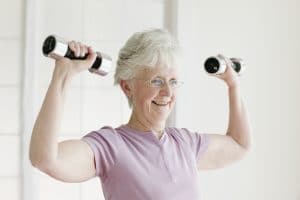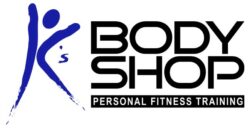Osteoporosis is a disease of the bones that affects men and women of all races, but white and Asian post-menopausal women are at higher risk.
Bone is living tissue that is constantly remodeling itself: breaking down the old and being replaced with new (which is how we are able to recover from fractures). Osteoporosis occurs when more bone is breaking down than is being rebuilt, leaving the skeleton weak, brittle, and easier to fracture.
Many things can contribute to lower bone density, such as certain medications, hormonal changes related to aging, smoking, alcohol abuse, the female athlete triad, or nutrition and exercise habits. Most people reach their peak bone mass in their early twenties when more new bone is being rebuilt compared to how much old bone is broken down, with a slow and steady decline over time.
Because of this, the best time to improve bone density is early if life so that you have “enough in the bank” to last through your golden years. So, how do you improve bone density? Nutrition and exercise! Given that I am a professional Personal Trainer who works with older adults, this article will focus primarily on osteoporosis exercise guidelines.

Osteoporosis Exercise Guidelines
In general, the most effective forms of exercise for improving bone density are strength training and weight bearing exercise.
Ideally, you will start with these activities early in life before reaching a stage of having osteoporosis.
While most people with osteopenia can handle these activities well, those who have progressed to osteoporosis need to take specific precautions. Exercise can help rebuild bone at any age or stage of the disease (I have a client who has improved enough to be back in the osteopenia stage), but you’ll need to have a customized program based on your current bone density scores and where your weaknesses are.
Special Considerations
The most common weak areas of bone in those with osteoporosis are at the wrist, spine, and femoral neck of the hip.
It is very important to avoid excessive spinal flexion (bending forward or sideways at the waist) or twisting during any activity, not just during exercise. You’ll want to consult with your physician or physical therapist concerning any restrictions before starting any osteoporosis exercise program. Be patient and listen to what your body tells you: avoid any activity that causes or increases pain.
Aerobic Exercise
While activities like swimming and cycling are great for aerobic fitness, they don’t do much for improving bone density.
Activities like walking, hiking, dancing, stair climbing, or group exercise classes are all examples of weight bearing exercise. These activities provide some benefit to the femoral neck and hip, but do nothing for the wrist or upper spine.
High impact activities like running, jogging, jumping rope, and plyometrics are all very effective at building bone before you have osteoporosis, but would be considered high risk once you’re there.
Aerobic exercises should be performed most days of the week for at least 30 minutes for general health.
Strength Training
Strength training is the golden ticket for improving bone density!
Resistance exercises such as free weights or elastic tubing generate muscle tension on the bones, which stimulates both muscles and bones to become stronger.
Depending on your specific bone density scores, certain osteoporosis exercises may be contraindicated or need to be modified, so have your physician or physical therapist review your program in advance. Examples could include shoulder presses or any exercise that places weight across your shoulders and loads the spine, such as barbell squats or some leg press machines.
Strength training exercises should be done a minimum of two non-consecutive days per week, with three times being ideal for increasing bone strength. Start with one set of each exercise for 10 reps and progress from there.
Flexibility
Stretching may be a beneficial part of your program depending on the range of motion of your joints.
Most people benefit from stretching exercises – which ones depend on what I find on your assessment. The same precautions about bending and twisting apply.
Stretching and mobility exercises can be done most days of the week.
Balance
Since many fractures occur as the result of a fall, improving your balance is an important component of your health and fitness program.
I do specific balance assessments on my older clients to establish a baseline as well as detect any trouble spots so that they can be improved.
Balance exercises should be done daily or even multiple times throughout the day.
Posture
Good posture can reduce stress on the neck and back and help to avoid developing common muscle imbalances. A stooped posture with extreme thoracic kyphosis in advanced stages of osteoporosis alters center of gravity and walking gait, so better posture results in better balance.
Postural exercises should be performed daily or even several times a day.
Nutrition
In addition to an osteoporosis exercise program, you’ll want to consult with a licensed nutritionist to determine what your calcium, magnesium, and vitamin D needs are as well as balanced eating for general health. Check out these radio shows about nutrition and osteoporosis that you can listen to for free!
This is an oversimplified article about a complex condition that requires careful medical management. I don’t think I’ve ever had a single client over the years who came to me for help with osteoporosis and that was their only medical condition. Most are older adults who also have cardiac risk factors, other orthopedic issues, are on multiple medications for other chronic diseases, or have already had at least one osteoporosis related fracture.
If you’re willing to do the work, it will probably take at least 9 months to a year to see any measurable changes in bone density. But, it CAN be done if you follow the osteoporosis exercise guidelines! Contact me today if you’re ready to get started!
Want to get FREE monthly fitness and nutrition tips delivered directly to your inbox? Access to early bird discounts and opportunities before the general public? Join for FREE now!

Pingback: No Bones about It: Exercise Is Great for Bone Health